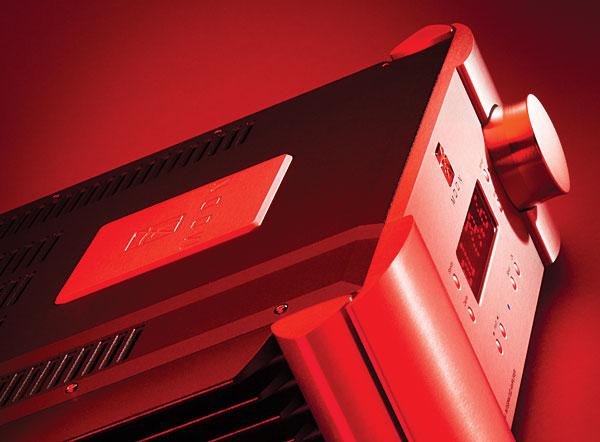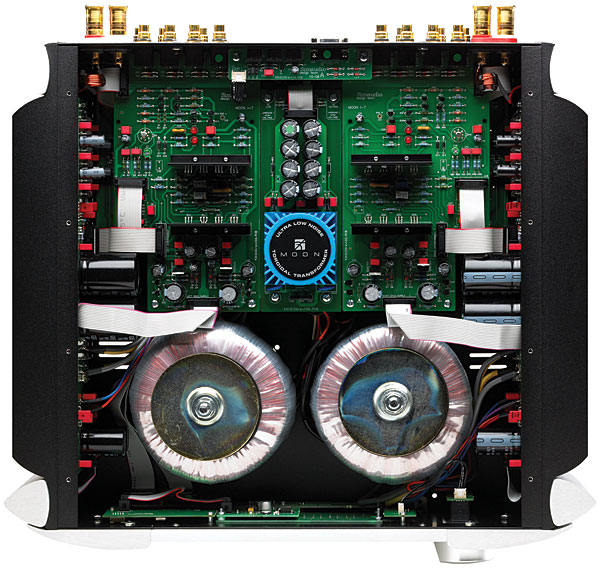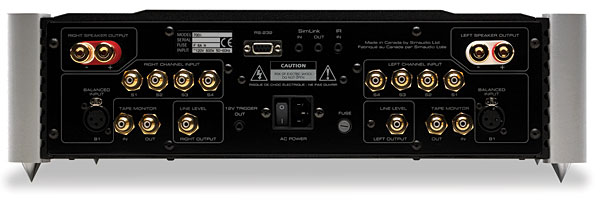| Columns Retired Columns & Blogs |
Simaudio Moon Evolution 700i integrated amplifier

In my review of Krell's FBI integrated amplifier in the July 2007 issue, I noted that $16,500 (it now costs $18,000) seemed an astonishing chunk of change to spend on a product category generally associated with "budget" gear. Now, the 2011 edition of the Stereophile Buyer's Guide lists no fewer than 19 companies selling integrated amps for five figures—one goes for $100,000!—which perhaps suggests that economic slumps prod even the well-heeled to alter their habits. There are, after all, advantages to cramming a preamplifier and a power amplifier into a single box: you need one less pair of interconnects, one less power socket, one less cabinet shelf. And if the integrated contains state-of-the-art parts, elegant circuitry, and a hefty power supply, what's the problem?
Footnote 1: The one clear advantage of separates over an otherwise identical integrated amp would be the formers' separate internal power supplies and the fact that each would suck current from its own power socket. But one potential, even likely, disadvantage would be the need for a pair of relatively long interconnects to link preamp and power amp—rather than, in an integrated, a short strand of pure copper or silver.
And so we have Simaudio Ltd., the veteran Canadian high-end electronics firm, leaping into this realm after 30 years of business with the Moon 700i, priced at $12,000—only two-thirds the price of the Krell, but aimed at the same downsizing but still toney demographic.
Description and Design
The 700i, part of Simaudio's top-of-the-line Moon Evolution series, is a fully differential dual-mono design that pumps 175Wpc into 8 ohms or 350Wpc into 4 ohms. The 700i runs in class-A up to 5W, and in class-A/B thereafter. Its output stages are powered by six bipolar transistors per channel, manufactured and matched to extremely high standards (claims the company's "white paper") for "exceptional gain-linearity," wider bandwidth, and a lower noise floor. Circuits are DC-coupled, which reportedly allows for a flat frequency response throughout, as well as below and beyond, the entire audioband. The 700i's "zero global feedback" design—which Simaudio's Lionel Goodfield, defines as "zero feedback except for just a little bit, locally, at the output stages only"—eliminates the need for signal correction, thus boosting the speed of the signal response, reducing phase errors and tonal colorations, and all but wiping out intermodulation distortion. Individual output devices are decoupled from one another, which is said to expand the power reserves of each, to produce a more effortlessly dynamic sound.
The circuit board has four layers of pure copper tracings—two for the audio signals, one each for the ground and power supplies—which makes possible very short signal paths and low levels of noise. The preamp section is mounted on its own dedicated circuit board, reducing crosstalk. The two very heavy toroidal transformers are precisely rolled from very-high-grade Japanese steel, designed in a proprietary process called Vacuum Pressure Impregnation, which is said to bolster the core's resistance to mechanical vibrations. The chassis—sleek with rounded edges, and remarkably compact for its 60 lbs—is made of thick, ultrarigid aluminum. Small, very sharp thumbscrew cones protrude from four wedge-like pillars to further reduce the effects of vibrations.

Other nifty tidbits include Simaudio's proprietary M-eVOL2 volume-control circuit, whose 530 steps let you adjust levels in increments of 0.1dB with a variation of less than 0.05dB between the left and right channels across the entire range of volume. A software feature called M-Lock lets you set and save a precise volume for each line input. Each input (one pair balanced XLRs, five pairs single-ended RCAs) can also be configured as "home-theater ready," with the gain section bypassed.
All this sounds good on paper. How does it actually sound?
System and Setup
I did all of my listening through Revel Ultima Studio2 loudspeakers. LPs were played on a VPI Classic turntable with JMW Memorial tonearm, a Lyra Delos moving-coil cartridge, and Nagra's BPS battery-powered phono preamp. Digital discs were spun on a Krell Evolution 505 SACD/CD player. Cables (single-ended from the phono, balanced from the CD player) were all by Nirvana. For a while, I conducted fairly extensive A/B comparisons of the Moon Evolution 700i and the Krell FBI. Setup was identical, except that, for the most part, I used Krell's proprietary CAST cables to link the Evolution 505 and FBI (using their CAST outputs and inputs, respectively).

The crew at Simaudio broke in the 700i for 200 hours before shipping it to me, but I found it needed to be kept powered up another 10 days before it came into its own. For the first week, the bass was a bit loose, the upper midrange harsh. After the full warmup (perhaps 400 hours, all told), that was no longer the case at all. Lionel Goodfield recommends leaving the 700i on all the time, and notes that if you turn it off for a week to, say, go out of town, it will take another three days to come back up to snuff after being turned back on.
Sound
I usually don't go in for comparative reviews. A piece of gear should be appraised on its own terms, or for how it stacks up to the sound of live music or some other audible standard. Pitting Amp X against Amp Y can be esoteric to the point of uselessness, if the reader isn't familiar with either model. But while 19 companies make integrated amps that cost more than ten grand, that's still an exclusive club, even by high-end standards. Given the relative oddity of that category, the Simaudio Moon 700i begged comparison with the Krell FBI, and as both were on hand, I figured I'd comply.
Some readers may recall that I went a bit wild for the FBI, and my view hasn't changed. (That review can be read at www.stereophile.com/content/krell-fbi-integrated-amplifier.) The 700i is in the same ballparks of price and quality, so I thought it might be useful—not just for the sake of comparing them, but as a way of taking the Moon's measure—to examine how they differed. These differences, in the scheme of things, are fairly minor, but they were noticeable—the sorts of variations that we audiophiles focus on, become attached to, even develop fetishes over. And they're differences; though the graphs of JA's measurements may ultimately argue otherwise, there's little to justify a pronouncement that one of these amps is better overall than the other. Even more than usual, a contest between them will, or should, be decided less by my verdict (which, as you'll see, is not entirely decided) than by your listening preferences.
Footnote 1: The one clear advantage of separates over an otherwise identical integrated amp would be the formers' separate internal power supplies and the fact that each would suck current from its own power socket. But one potential, even likely, disadvantage would be the need for a pair of relatively long interconnects to link preamp and power amp—rather than, in an integrated, a short strand of pure copper or silver.
- Log in or register to post comments




































